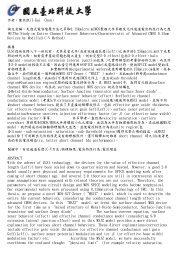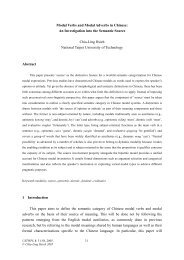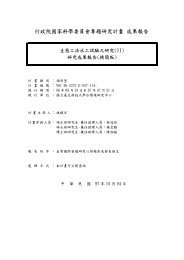Dispersion of carbon black in a continuous phase ... - NTUT IR
Dispersion of carbon black in a continuous phase ... - NTUT IR
Dispersion of carbon black in a continuous phase ... - NTUT IR
You also want an ePaper? Increase the reach of your titles
YUMPU automatically turns print PDFs into web optimized ePapers that Google loves.
Colloid Polym Sci (2002) 280: 1110–1115<br />
DOI 10.1007/s00396-002-0718-8<br />
S.-P. Rwei<br />
F.-H. Ku<br />
K.-C. Cheng<br />
Received: 17 October 2001<br />
Revised: 11 April 2002<br />
Accepted: 15 April 2002<br />
Published onl<strong>in</strong>e: 20 June 2002<br />
Ó Spr<strong>in</strong>ger-Verlag 2002<br />
S.-P. Rwei (&) Æ F.-H. Ku<br />
Institute <strong>of</strong> Organic and Polymeric<br />
Materials, National Taipei University<br />
<strong>of</strong> Technology, Taipei, Taiwan, R.O.C.<br />
E-mail: f10714@ntut.edu.tw<br />
Tel.: +886–2-27712171 ext. 2432<br />
Fax: +886–2-27317174<br />
K.-C. Cheng<br />
Department <strong>of</strong> Chemical Eng<strong>in</strong>eer<strong>in</strong>g,<br />
National Taipei University <strong>of</strong> Technology,<br />
Taipei, Taiwan, R.O.C.<br />
Introduction<br />
The electric conductivity <strong>of</strong> an <strong>in</strong>sulat<strong>in</strong>g polymer can be<br />
<strong>in</strong>creased when it is compounded with conductive fillers<br />
such as copper powders, silver powders, and <strong>carbon</strong><br />
<strong>black</strong> powders. The improvement obta<strong>in</strong>ed with metal<br />
powders is <strong>in</strong>significant because the metal particles are<br />
too large to create sufficient contacts. Among all the<br />
available fillers, <strong>carbon</strong> <strong>black</strong> (CB) is the most effective<br />
one [1, 2, 3, 4, 5, 6, 7, 8, 9].<br />
Carbon <strong>black</strong> is formed by combust<strong>in</strong>g heavy oils<br />
<strong>in</strong> a furnace. The <strong>carbon</strong> condenses <strong>in</strong> droplets, called<br />
prime particles. The prime particles coalesce <strong>in</strong>to<br />
ORIGINAL CONTRIBUTION<br />
<strong>Dispersion</strong> <strong>of</strong> <strong>carbon</strong> <strong>black</strong> <strong>in</strong> a cont<strong>in</strong>uous<br />
<strong>phase</strong>: Electrical, rheological,<br />
and morphological studies<br />
Abstract This work <strong>in</strong>vestigates the<br />
dispersion <strong>of</strong> <strong>carbon</strong> <strong>black</strong> (CB)<br />
aggregates <strong>in</strong>to various polymeric<br />
matrices to <strong>in</strong>crease electric<br />
conductivity. The effect <strong>of</strong> matrix<br />
viscosity on CB morphology and,<br />
consequently, on the blend conductivity<br />
was thoroughly addressed.<br />
The electric conductivity <strong>in</strong>creases<br />
from 10 –9 to 10 –4 when less than<br />
3% CB aggregates were dispersed<br />
<strong>in</strong>to the PDMS liquid <strong>of</strong> various<br />
viscosities. The CB threshold load<strong>in</strong>g<br />
was found to <strong>in</strong>crease from 1%<br />
to 3% as the viscosity rose from<br />
10 cp to 60 000 cp. This f<strong>in</strong>d<strong>in</strong>g<br />
shows that an ideal load<strong>in</strong>g with<br />
CB aggregates is far below that<br />
(generally 15%) <strong>of</strong> a typical pelletized<br />
CB load<strong>in</strong>g. Moreover, the<br />
microscope and RV tests reveal that<br />
CB aggregates diffuse and form an<br />
agglomerate-network when the<br />
conductivity threshold is reached<br />
<strong>in</strong> a low-viscosity matrix. However,<br />
a CB aggregate-network was<br />
observed when the threshold value<br />
was atta<strong>in</strong>ed <strong>in</strong> a high-viscosity<br />
matrix. These two mechanisms can<br />
be dist<strong>in</strong>guished at approximately<br />
1000 cp. F<strong>in</strong>ally, experimental<br />
observation shows that the <strong>in</strong>crease<br />
<strong>of</strong> viscosity dur<strong>in</strong>g cur<strong>in</strong>g does not<br />
<strong>in</strong>fluence the conductivity <strong>of</strong> the<br />
composite while the CB aggregates<br />
dispersed <strong>in</strong> a thermoset matrix.<br />
The m<strong>in</strong>imum viscosity dur<strong>in</strong>g<br />
cur<strong>in</strong>g, however, was found to be<br />
critical to CB dispersion morphology<br />
and, consequently, to ultimate<br />
electric conductivity.<br />
Keywords Electric conductivity Æ<br />
Matrix viscosity Æ Aggregatenetwork<br />
Æ Agglomerate-network Æ<br />
Conductivity threshold<br />
aggregates. Aggregates composed <strong>of</strong> few prime particles<br />
compactly fuse to form low-structure <strong>black</strong>s; those<br />
<strong>of</strong> many prime particles can generate high-structure<br />
<strong>black</strong>s with considerable branches. For a given mass<br />
<strong>of</strong> CB aggregates, a high-structure <strong>black</strong> usually presents<br />
a greater surface area for electron conduction<br />
than does a low-structure <strong>black</strong>. However, once the<br />
structure is built, typical hydrodynamic shear forces<br />
cannot deform it. This paper uses the term ‘‘fluffy’’ to<br />
denote high-structure CB aggregates that exhibit good<br />
conductivity. In certa<strong>in</strong> situations, aggregates can<br />
cluster <strong>in</strong>to large groups, bound by Van der Waals<br />
forces, called agglomerates. Agglomerates are typically
10–100 lm <strong>in</strong> size and can be broken by hydrodynamic<br />
forces.<br />
Compound<strong>in</strong>g plastic with conductive fluffy CB can<br />
<strong>in</strong>crease the conductivity by five to six orders <strong>of</strong> magnitude.<br />
Such an application was commercialized over<br />
twenty years ago and has been widely employed <strong>in</strong> antistatic<br />
or filtration fields. Conductive blends can be<br />
prepared <strong>in</strong> several ways. The most popular method is to<br />
compound CB pellets (about 1–2 mm <strong>in</strong> size) <strong>in</strong>to a<br />
polymeric matrix, us<strong>in</strong>g a banbury mixer or tw<strong>in</strong>-screw<br />
extruder [10, 11, 12, 13, 14, 15, 16, 17, 18]. However,<br />
most related studies have focused on improv<strong>in</strong>g bulk<br />
properties, such as electric conductivity or mechanical<br />
properties <strong>of</strong> the blends, as the CB agglomerates were<br />
dispersed <strong>in</strong>to the polymeric matrix by <strong>in</strong>tensive shear<strong>in</strong>g.<br />
Scientists generally agree that for a given weight <strong>of</strong><br />
<strong>carbon</strong> <strong>black</strong>, f<strong>in</strong>er agglomerates enable more particles<br />
to be evenly distributed <strong>in</strong> a fixed volume <strong>of</strong> plastic.<br />
Thus, smaller <strong>in</strong>terparticular distances can be achieved<br />
and, consequently, electrons can be transferred from<br />
particle to particle throughout the matrix. Accord<strong>in</strong>gly,<br />
a system that <strong>in</strong>cludes all its CB particles <strong>in</strong> fluffy form,<br />
with the size <strong>of</strong> aggregate, may be <strong>in</strong> its optimal condition<br />
for electron conductivity. However, the impact <strong>of</strong><br />
matrix properties, such as viscosity and the degree <strong>of</strong><br />
crossl<strong>in</strong>k<strong>in</strong>g, on the aggregate dispersion and, consequently,<br />
on the blend’s conductivity have not been extensively<br />
exam<strong>in</strong>ed.<br />
This work focuses on the dispersion <strong>of</strong> conductive<br />
fluffy CB <strong>in</strong> PDMS (poly-dimethyl siloxane) liquid <strong>of</strong><br />
various viscosities. The dispersion morphology was related<br />
to the electric conductivity <strong>of</strong> the blend. The effects<br />
<strong>of</strong> crossl<strong>in</strong>k<strong>in</strong>g <strong>of</strong> the polymeric matrix on the CB dispersion<br />
and on the conductivity <strong>of</strong> the thermoset composite<br />
were also exam<strong>in</strong>ed. This study aims to yield<br />
further <strong>in</strong>sight <strong>in</strong>to the relationship between CB dispersion<br />
and the result<strong>in</strong>g conductivity <strong>in</strong> a fixed, thermoplastic<br />
system over a range <strong>of</strong> viscosities and a<br />
thermoset system. Results <strong>in</strong> this study can be applied to<br />
assess the ideal compound<strong>in</strong>g ratio <strong>of</strong> CB aggregates <strong>in</strong> a<br />
given polymeric system. Moreover, the discrepancy between<br />
the feed<strong>in</strong>g ratio <strong>of</strong> an ideal and that <strong>of</strong> a real<br />
system, <strong>in</strong>to which CB is compounded, is reasonably<br />
expla<strong>in</strong>ed.<br />
Experimental procedures<br />
Fluffy <strong>carbon</strong> <strong>black</strong> (CB) was used as a conductive filler: Vulcan<br />
XC72, supplied by Cabot, had aggregate density <strong>of</strong> 1.8 g/cm 3 ,a<br />
surface area <strong>of</strong> 254 m 2 /g (N2), and a plasticizer absorption value,<br />
DBP (dibutyl phthalate), <strong>of</strong> 188 ml/100 g. Various grades <strong>of</strong><br />
poly(dimethyl siloxane) (PDMS, 99.6% purity) from Dow Cornig,<br />
with viscosities from 10 cp to 60 000 cp were used as suspend<strong>in</strong>g<br />
media for the fluffy CB powders. Uncrossl<strong>in</strong>ked silicon rubber<br />
(RTV-573, Rhodorsil) with a crossl<strong>in</strong>k<strong>in</strong>g agent (60R, Rhodorsil)<br />
was used as another CB suspension medium with a structure similar<br />
to that <strong>of</strong> PDMS but that was curable at room temperature.<br />
In the experiment with PDMS as the medium, fluffy CB was<br />
poured <strong>in</strong>to a PDMS matrix <strong>in</strong> a high-shear ball miller. The volume<br />
fraction <strong>of</strong> the CB aggregates <strong>in</strong> the suspension ranged from 1% to<br />
4.5% and each sample was sheared with<strong>in</strong> 36 h for perfect dispersion.<br />
An optical microscope (Nikon AFX-DX) was employed to<br />
observe particle distribution follow<strong>in</strong>g dispersion. Transmission<br />
micrographs were obta<strong>in</strong>ed us<strong>in</strong>g a mounted camera. A t<strong>in</strong>y<br />
amount <strong>of</strong> suspension (4–5 ll) was dropped onto a glass slide and<br />
phoyographs <strong>of</strong> random locations were taken. The viscosity was<br />
measured <strong>in</strong> a DV-III cone and plate rheometer (Brookfield) for<br />
low viscosity blends (1–10 5 cp), and <strong>in</strong> a SR-5 parallel plate rheometer<br />
for high viscosity blends (>10 4 cp). The electric conductivity<br />
was measured us<strong>in</strong>g a RT-1000 multimeter (Marlborough),<br />
on a cell with two <strong>in</strong>serted, 1·1·0.05 cm 3 metal electrodes, separated<br />
by 3 cm.<br />
In the experiments with CB epoxy composite, DER-331 (Diglycidyl<br />
ether <strong>of</strong> bisphenol A; Dow Chemical) comb<strong>in</strong>ed with<br />
cur<strong>in</strong>g agent HN-2200 (cycloaliphatic anhydride, Hitachi) were<br />
used as a suspend<strong>in</strong>g medium. The fluffy CB was separately dispersed<br />
<strong>in</strong>to DER-331 and HN-2200 matrices, follow<strong>in</strong>g the mill<strong>in</strong>g<br />
procedure mentioned above. The well-dispersed samples were<br />
mixed <strong>in</strong> the ratio 5:4 (DER-331: HN-2200) and the rheology test<br />
to monitor cur<strong>in</strong>g and the conductivity test follow<strong>in</strong>g post-cure<br />
were then performed. The morphology <strong>of</strong> the CB-filled composites<br />
was exam<strong>in</strong>ed by optical microscopy mentioned above. Th<strong>in</strong> sections<br />
(1 lm) were prepared us<strong>in</strong>g a MT 990 microtome (RMC).<br />
Results and discussion<br />
1111<br />
Figure 1 illustrates the dependence <strong>of</strong> the electric conductivity,<br />
<strong>in</strong> (W-cm) –1 , on the volume fraction <strong>of</strong> CB<br />
powders for various PDMS viscosities. Figure 1 reveals<br />
that, for a low viscosity PDMS (10 cp), the conductivity<br />
<strong>in</strong>creases sharply with CB load<strong>in</strong>g. The conductivity<br />
then becomes saturated at conductivity around 10 –4 and<br />
changes <strong>in</strong>significantly when the CB load<strong>in</strong>g is further<br />
<strong>in</strong>creased. Figure 1 reveals two notable phenomena.<br />
First, the saturation po<strong>in</strong>ts <strong>in</strong>crease with the viscosity<br />
<strong>of</strong> PDMS, contradict<strong>in</strong>g the prediction <strong>of</strong> percolation<br />
Fig. 1 Dependence <strong>of</strong> the electrical conductivity on the volume<br />
fraction <strong>of</strong> <strong>carbon</strong> <strong>black</strong> dispersed <strong>in</strong> PDMS liquids with various<br />
viscosities. Diamonds on solid l<strong>in</strong>e 10 cp, triangles 100 cp, diamonds<br />
on dotted l<strong>in</strong>e 500 cp, crosses 1000 cp, asterix 60 000 cp, circles<br />
silicon rubber








